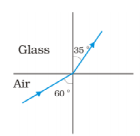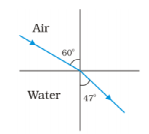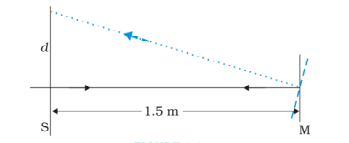Complete Solutions to EXERCISE of chapter RAY OPTICS AND OPTICAL INSTRUMENTS of Class 12 book with complete answers and questions
| Class 12 | PHYSICS |
| Chapter | RAY OPTICS AND OPTICAL INSTRUMENTS |
| PSEB | EXERCISE |
| Number Of Questions | 62 |
| Academic Year | 2023-24 |
A small candle, 2.5 cm in size is placed at 27 cm in front of a concave mirror of radius of curvature 36 cm. At what distance from the mirror should a screen be placed in order to obtain a sharp image? Describe the nature and size of the image. If the candle is moved closer to the mirror, how would the screen have to be moved?
View SolutionA 4.5 cm needle is placed 12 cm away from a convex mirror of focal length 15 cm. Give the location of the image and the magnification. Describe what happens as the needle is moved farther from the mirror.
View SolutionA tank is filled with water to a height of 12.5 cm. The apparent depth of a needle lying at the bottom of the tank is measured by a microscope to be 9.4 cm. What is the refractive index of water? If water is replaced by a liquid of refractive index 1.63 up to the same height, by what distance would the microscope have to be moved to focus on the needle again?
View SolutionFigures (a) and (b) show refraction of a ray in air incident at `60^@` with the normal to a glass-air and water-air interface, respectively. Predict the angle of refraction in glass when the angle of incidence in water is `45^@`with the normal to a water-glass interface [Fig. (c)]. :



View SolutionA small bulb is placed at the bottom of a tank containing water to a depth of 80cm. What is the area of the surface of water through which light from the bulb can emerge out? Refractive index of water is 1.33. (Consider the bulb to be a point source.)
View SolutionA prism is made of glass of unknown refractive index. A parallel beam of light is incident on a face of the prism. The angle of minimum deviation is measured to be `40^@`. What is the refractive index of the material of the prism? The refracting angle of the prism is `60^@`. If the prism is placed in water (refractive index 1.33), predict the new angle of minimum deviation of a parallel beam of light.
View SolutionDouble-convex lenses are to be manufactured from a glass of refractive index 1.55, with both faces of the same radius of curvature. What is the radius of curvature required if the focal length is to be 20cm?
View SolutionA beam of light converges at a point P. Now a lens is placed in the path of the convergent beam 12cm from P. At what point does the beam converge if the lens is: a convex lens of focal length 20cm?
View SolutionA beam of light converges at a point P. Now a lens is placed in the path of the convergent beam 12cm from P. At what point does thebeam converge if the lens is: a concave lens of focal length 16cm?
View SolutionAn object of size 3.0cm is placed 14cm in front of a concave lens of focal length 21cm. Describe the image produced by the lens. What happens if the object is moved further away from the lens?
View SolutionWhat is the focal length of a convex lens of focal length 30cm in contact with a concave lens of focal length 20cm? Is the system a converging or a diverging lens? Ignore thickness of the lenses.
View SolutionA compound microscope consists of an objective lens of focal length 2.0 cm and an eyepiece of focal length 6.25 cm separated by a distance of 15 cm. How far from the objective should an object be placed in order to obtain the final image at the least distance of distinct vision (25 cm)? What is the magnifying power of the microscope in?
View SolutionWhat is the focal length of a convex lens of focal length 30cm in contact with a concave lens of focal length 20cm? Is the system a converging or a diverging lens? Ignore thickness of the lenses.
View SolutionA person with a normal near point (25 cm) using a compound microscope with objective of focal length 8.0 mm and an eyepiece of focal length 2.5cm can bring an object placed at 9.0mm from the objective in sharp focus. What is the separation between the two lenses? Calculate the magnifying power of the microscope.
View SolutionA small telescope has an objective lens of focal length 144cm and an eyepiece of focal length 6.0cm. What is the magnifying power of the telescope? What is the separation between the objective and the eyepiece?
View SolutionA giant refracting telescope at an observatory has an objective lens of focal length 15m. If an eyepiece of focal length 1.0cm is used, what is the angular magnification of the telescope?
View SolutionA telescope has objective lens of focal length 15m. If this telescope is used to view the moon, what is the diameter of the image of the moon formed by the objective lens? The diameter of the moon is `3.48 xx 10^6m`, and the radius of lunar orbit is `3.8 xx 10^8m`.
View SolutionUse the mirror equation to deduce that: an object placed between f and 2f of a concave mirror produces a real image beyond 2f.
View SolutionUse the mirror equation to deduce that: a convex mirror always produces a virtual image independent of the location of the object.
View SolutionUse the mirror equation to deduce that: the virtual image produced by a convex mirror is always diminished in size and is located between the focus and the pole.
View SolutionUse the mirror equation to deduce that: an object placed between the pole and focus of a concave mirror produces a virtual and enlarged image.
View SolutionA small pin fixed on a table top is viewed from above from a distance of 50cm. By what distance would the pin appear to be raised if it is viewed from the same point through a 15cm thick glass slab held parallel to the table? Refractive index of glass = 1.5. Does the answer depend on the location of the slab?
View SolutionFigure 9.35 shows a cross-section of a glass fibre of refractive index 1.68. The outer covering of the pipe is made of a material of refractive index 1.44. What is the range of the angles of the incident rays with the axis of the pipe for which total reflections inside the pipe take place, as shown in the figure. :

View SolutionFigure 9.35 shows a cross-section of a glass fibre of refractive index 1.68. The outer covering of the pipe is made of a material of refractive index 1.44. What is the range of the angles of the incident rays with the axis of the pipe for which total reflections inside the pipe take place, as shown in the figure. What is the answer if there is no outer covering of the pipe? :

View SolutionAnswer the following questions: You have learnt that plane and convex mirrors produce virtual images of objects. Can they produce real images under some circumstances? Explain.
View SolutionAnswer the following questions: A virtual image, we always say, cannot be caught on a screen. Yet when we ‘see’ a virtual image, we are obviously bringing it on to the ‘screen’ (i.e. the retina) of our eye. Is there a contradiction?
View SolutionAnswer the following questions: A diver under water, looks obliquely at a fisherman standing on the bank of a lake. Would the fisherman look taller or shorter tothe diver than what he actually is?
View SolutionAnswer the following questions: Does the apparent depth of a tank of water change if viewed obliquely? If so, does the apparent depth increase or decrease?
View SolutionAnswer the following questions: The refractive index of diamond is much greater than that of ordinary glass. Is this fact of some use to a diamond cutter?
View SolutionThe image of a small electric bulb fixed on the wall of a room is to be obtained on the opposite wall 3m away by means of a large convex lens. What is the maximum possible focal length of the lens required for the purpose?
View SolutionA screen is placed 90cm from an object. The image of the object on the screen is formed by a convex lens at two different locations separated by 20cm. Determine the focal length of the lens.
View SolutionDetermine the ‘effective focal length’ of the combination of the two lenses convex lens of focal length 30cm in contact with a concave lens of focal length 20cm, if they are placed 8.0 cm apart with their principal axes coincident. Does the answer depend on which side of the combination a beam of parallel light is incident? Is the notion of effective focal length of this system useful at all?
View SolutionTwo lenses convex lens of focal length 30 cm in contact with a concave lens of focal length 20 cm, if they are placed 8.0 cm apart with their principal axes coincident. An object 1.5 cm in size is placed on the side of the convex lens. The distance between the object and the convex lens is 40 cm. Determine the magnification produced by the two-lens system, and the size of the image.
View SolutionAt what angle should a ray of light be incident on the face of a prism of refracting angle `60^@` so that it just suffers total internal reflection at the other face? The refractive index of the material of the prism is 1.524.
View SolutionYou are given prisms made of crown glass and flint glass with a wide variety of angles. Suggest a combination of prisms which will- deviate a pencil of white light without much dispersion.
View SolutionYou are given prisms made of crown glass and flint glass with a wide variety of angles. Suggest a combination of prsims which will- disperse (and displace) a pencil of white light without much deviation.
View SolutionFor a normal eye, the far point is at infinity and the near point of distinct vision is about 25cm in front of the eye. The cornea of the provides a converging power of about 40 dioptres, and the leas converging power of the eye-lens behind the cornea is about 20 dioptres. From this rough data estimate the range of accommodation (i.e., the range of converging power of the eye-lens) of a normal eye.
View SolutionDoes short-sightedness (myopia) or long-sightedness (hyper metropia) imply necessarily that the eye has partially lost its ability of accommodation? If not, what might cause these defects of vision?
View SolutionA myopic person has been using spectacles of power -1.0D for distant vision. During old age he also needs to use separate reading glass of power +2.0 dioptres. Explain what may have happened.
View SolutionA person looking at a person wearing a shirt with a pattern comprising vertical and horizontal lines is able to see the vertical lines more distinctly than the horizontal ones. What is this defect due to? How is such a defect of vision corrected?
View SolutionA man with normal near point (25 cm) reads a book with small print using a magnifying glass: a thin convex lens of focal length 5 cm- What is the closest and the farthest distance at which he should keep the lens from the page so that he can read the book when viewing through the magnifying glass?
View SolutionA man with normal near point (25 cm) reads a book with small print using a magnifying glass: a thin convex lens of focal length 5 cm- What is the maximum and the minimum angular magnification (magnifying power) possible using the above simple microscope?
View SolutionA card sheet divided into squares each of size `1 mm^2` is being viewed at a distance of 9 cm through a magnifying glass (a converging lens focal length 10 cm) held close to the eye. What is the magnification produced by the lens? How much is the area of each square in the virtual image?
View SolutionA card sheet divided into squares each of size `1 mm^2` is being viewed at a distance of 9 cm through a magnifying glass (a converging lens of focal length 9 cm) held close to the eye. What is the angular magnification (magnifying power) of the lens?
View SolutionA card sheet divided into squares each of size `1 mm^2` is being viewed at a distance of 9 cm through a magnifying glass (a converging lens of focal length 9 cm) held close to the eye. What is the angular magnification (magnifying power) of the lens?
View SolutionAt what distance should the converging lens of focal length 10 cm be held in order to view the squares distinctly with the maximum possible magnifying power?
View SolutionAt what distance should the converging lens of focal length 10 cm be held in order to view the squares distinctly with the maximum possible magnifying power? What is the magnification in this case?
View SolutionAt what distance should the converging lens of focal length 10 cm be held in order to view the squares distinctly with the maximum possible magnifying power? Is the magnification equal to the magnifying power in this case? Explain.
View SolutionA card sheet divided into squares each of size `1 mm^2` is being viewed at a distance of 9 cm through a magnifying glass (a converging lens of focal length 10 cm) held close to the eye. What should be the distance between the object in converging lens and the magnifying glass if the virtual image of each square in the figure is to have an area of `6.25 mm^2`. Would you be able to see the squares distinctly with your eyes very close to the magnifier ?
View SolutionAnswer the following questions: The angle subtended at the eye by an object is equal to the angle subtended at the eye by the virtual image produced by a magnifying glass. In what sense then does a magnifying glass provide angular magnification?
View SolutionAnswer the following question: In viewing through a magnifying glass, one usually positions one’s eyes very close to the lens. Does angular magnification change if the eye is moved back?
View SolutionAnswer the following questions: Magnifying power of a simple microscope is inversely proportional to the focal length of the lens. What then stops us from using a convex lens of smaller and smaller focal length and achieving greater and greater magnifying power?
View SolutionAnswer the following questions: Why must both the objective and the eyepiece of a compound microscope have short focal lengths?
View SolutionAnswer the following questions: When viewing through a compound microscope, our eyes should be positioned not on the eyepiece but a short distance away from it for best viewing. Why? How much should be that short distance between the eye and eyepiece?
View SolutionAn angular magnification (magnifying power) of 30X is desired using an objective of focal length 1.25cm and an eyepiece of focal length 5cm. How will you set up the compound microscope?
View SolutionA small telescope has an objective lens of focal length 140cm and an eyepiece of focal length 5.0cm. What is the magnifying power of the telescope for viewing distant objects when- the telescope is in normal adjustment (i.e., when the final image is at infinity)?
View SolutionA small telescope has an objective lens of focal length 140cm and an eyepiece of focal length 5.0cm. What is the magnifying power of the telescope for viewing distant objects when- the final image is formed at the least distance of distinct vision (25cm)?
View SolutionA small telescope has an objective lens of focal length 140 cm and an eyepiece of focal length 5.0 cm. what is the separation between the objective lens and the eyepiece?
View SolutionA small telescope has an objective lens of focal length 140 cm and an eyepiece of focal length 5.0 cm. (A) what is the separation between the objective lens and the eyepiece? (B) If this telescope is used to view a 100 m tall tower 3 km away, what is the height of the image of the tower formed by the objective lens?
View SolutionA small telescope has an objective lens of focal length 140 cm and an eyepiece of focal length 5.0 cm. (A) If this telescope is used to view a 100 m tall tower 3 km away, what is the height of the image of the tower formed by the objective lens? (B) What is the height of the final image of the tower if it is formed at 25 cm?
View SolutionA Cassegrain telescope uses two mirrors as shown in Fig. 9.33. Such a telescope is built with the mirrors 20mm apart. If the radius of curvature of the large mirror is 220mm and the small mirror is 140mm, where will the final image of an object at infinity be?
View SolutionLight incident normally on a plane mirror attached to a galvanometer coil retraces backwards as shown in Fig. 9.36. A current in the coilproduces a deflection of `3.5^` of the mirror. What is the displacement of the reflected spot of light on a screen placed 1.5 m away?:

View Solution
EXERCISE questions and complete solutions for chapter RAY OPTICS AND OPTICAL INSTRUMENTS of PSEB of Class 12